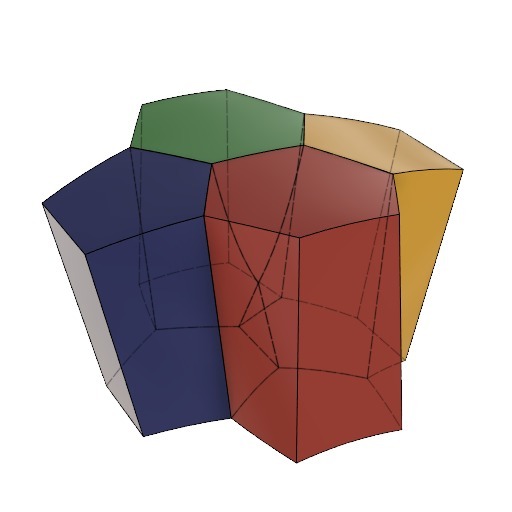
Scutoid, Four Cell Configuration
thingiverse
Human: I came across a groundbreaking discovery in Nature announcing the unveiling of a "new" shape, scutoids, which offers a geometric solution to three-dimensional packing of epithelia. However, upon closer inspection, I found the mathematical definition of a scutoid to be somewhat ambiguous. I suspect that rather than being previously unknown, as headlines suggest, it was left unnamed due to its messy geometrical nature. Its closest relative, the prismatoid, boasts nice planar faces, whereas the scutoid often features non-planar faces and a "mid-level vertex." Subjectively speaking, the scutoid appears a bit clumsy in isolation but shines when coupled with other mating scutoids. The significance of this shape lies in its newly discovered abundance in nature, where its hidden vertex is shielded from view by adjacent cells. The paper didn't provide an Euclidean definition and even left the definition vague enough to tantalize the possibility of multiple mid-level vertices and therefore hexagonal to trapezoidal transformations. The paper did offer helpful visuals and kernels of plain-speak explanation that I used to create the model. I focused on the tubular model with its basal and apical surfaces, but I didn't use Voronoi calculations to create the model, which would have been a shortcut since the shape of scutoids in nature is dependent upon their Voronoi relations to neighboring cells. In fact, the realization that Voronoi cells can change both shape and configuration when squeezed to a smaller surface was the impetus for the discovery. Notice how touching red and green hexagons transform into non-touching pentagons, and non-touching blue and yellow pentagons transform into touching hexagons. Does this model tessellate beyond four parts? No, I think the door is open for further exploration into how scutoids can be packed in a theoretical and virtual environment. As for printing, I recommend using vase mode (scutoid_vase_1-2), which speeds up the print, eliminates the need for supports, and allows one to see within the cells. I've attached the original curved cell files depicting basal and apical surfaces (scutoid_arched_1-2). Much thanks to previous contributors, especially mathgrrl.
With this file you will be able to print Scutoid, Four Cell Configuration with your 3D printer. Click on the button and save the file on your computer to work, edit or customize your design. You can also find more 3D designs for printers on Scutoid, Four Cell Configuration.
